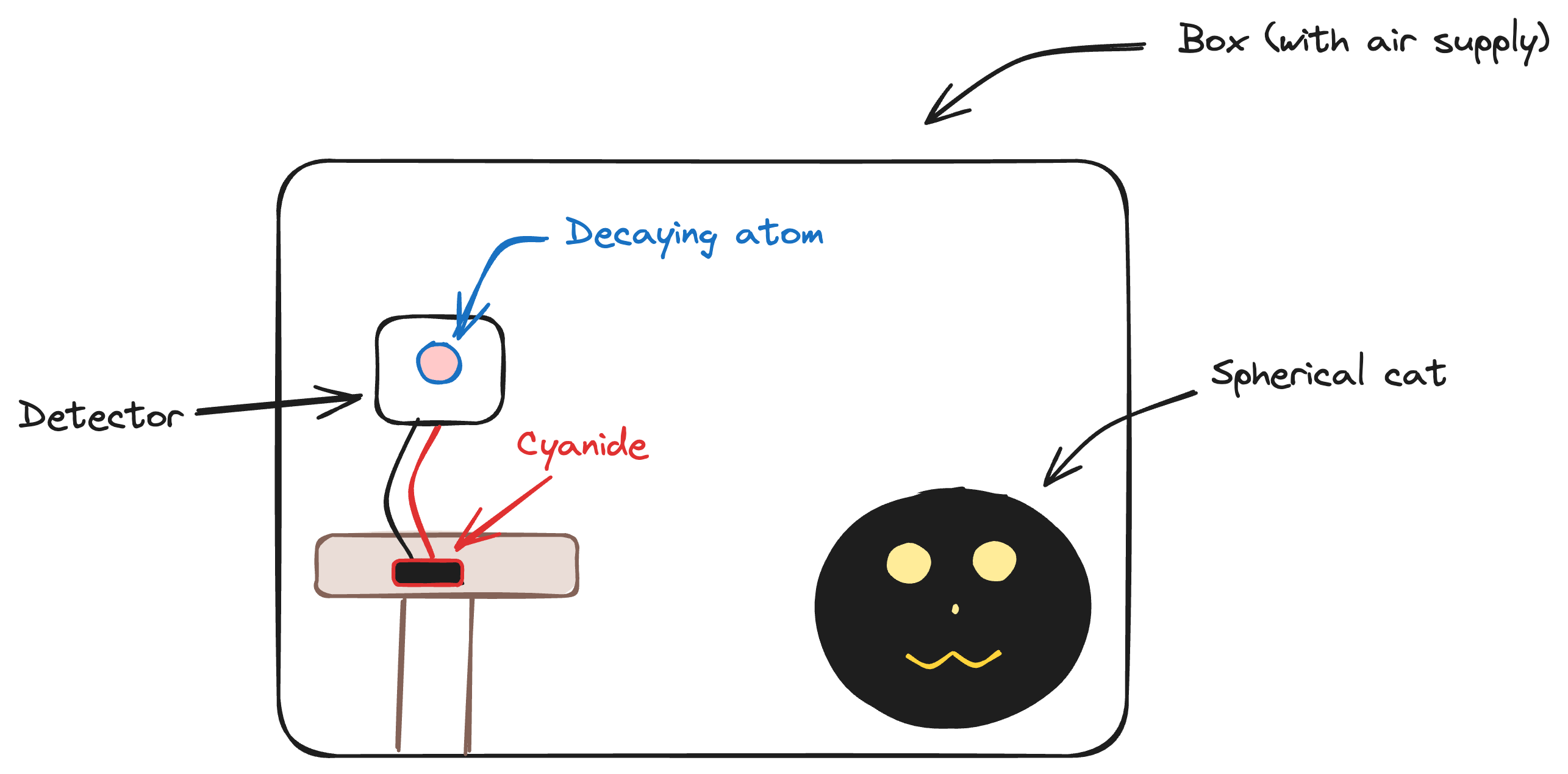Chapter 4 - Quantum Spookiness
Reference Quantum Mechanics: A Paradigms Approach by David McIntyre.
In the 20th century, as quantum mechanics was first developing widespread acknowledgement, various theories were put forth to try and explain the probabilistic (rather than deterministic) nature that surprised a lot of classical physicists.
Einstein-Podolsky-Rosen Paradox (EPR)
Some, such as Albert "God does not play dice" Einstein, thought the probabilistic nature of QM (especially when juxtaposed with the more-deterministic classical mechanics) was just because we weren't seeing some variables - we thought it probabilistic only because there was some backstage action we weren't seeing (an incomplete description of reality).
The experiment begins with an unstable particle with spin 0, which then decays into two spin particles (consv. of angular momentum) traveling in opposite directions (consv. of linear momentum).

Because each spin is opposite the other, if observer 1 sees spin +1/2, observer 2 must see spin -1/2, and visa versa. After measurement, each observer always knows what the other observer sees.
This would be later called an entangled state.
There are two ways of looking at these particles:
- Each exists as part of a state that is in superposition, so neither particle has a defined spin until measurement.
- Both particles have spin values defined at the moment of decay - particle 1 always had spin , particle 2 always spin .
For example, imagine a particle decays on Earth, and the resulting 1/2 particles are kept (unmeasured) in two chambers (i.e. the quantum state describing both is in superposition by view 1). One 1/2 particle is sent with a ship to Mars, and another is sent on a ship to Alpha Centauri.
 If Mars makes the measurement , according to idea 1, the state instantaneously collapses into the state and Alpha Centauri will measure , regardless of the distance between the two. Idea 2 says that Mars always had , while perspective 1 maintains that the superposition state must have collapsed then.
If Mars makes the measurement , according to idea 1, the state instantaneously collapses into the state and Alpha Centauri will measure , regardless of the distance between the two. Idea 2 says that Mars always had , while perspective 1 maintains that the superposition state must have collapsed then.
The EPR paradox argues in favor of the second: the spin is a "real" property of the particle - a variable (invisible to our instruments then) describing reality. Instead of being in a superposition state pre-measurement, both particles had their spin states specified at the moment of decay and always did - Einstein's local hidden variables theory (localized to each particle).
For a while, it was thought impossible to know whether theory 1 or theory 2 was the correct interpretation ... that is, until 1964. Enter John Bell.
Bell's Theorem
Bell's theorem sets up a mathematical inequality that provides different results for a setup assuming HVT and a setup assuming the Copenhagen interpretation.
In the hidden variables theory (HVT) interpretation, this equality is where and represent the measurements taken by two observers and and denotes the expectation (or average) value of some measurement. This inequality is also called the Clauser-Horne-Shimony-Holt (CHSH) inequality.
Now, assume this was set up with qubits instead - see the Wikipedia article for more details. Summing the expectation values yields which is greater than the maximum of 2 allowed by the CHSH inequality, implying hidden variables cannot exist.
Schrödinger's Cat
Schrödinger, in a fit of psychosis, proposed putting a cat in a box. Never a good idea - but further, he decided that box should include both unstable radioactive isotopes and a bottle of cyanide! If an isotope decay is detected, boom. Dead cat.
 Now, this is a dumb experiment for so many reasons (animal cruelty not the least of which), but it's animal cruelty for science ... so ... yeah. That doesn't even justify it. Whatever. Don't do this experiment at home or anywhere else for that matter.
Now, this is a dumb experiment for so many reasons (animal cruelty not the least of which), but it's animal cruelty for science ... so ... yeah. That doesn't even justify it. Whatever. Don't do this experiment at home or anywhere else for that matter.
The atom has a half life of 1 hour. After 1 hour, the state of the life-deciding decaying atom is described by ... with the quantum state of the cat implied to be ... implying the cat is in a superposition state between dead and alive. Purgatory's got nothing on Schrödinger's pets. This (thankfully only) thought experiment raises two questions:
- Can macroscopic (cat) states be described quantum mechanically?
- What qualifies as a measurement? I.e. what causes the collapse of the wave function?
The Copenhagen interpretation states that, no, cats (nor any other macroscopic thing for that matter) cannot be represented by quantum functions - only classically, like with ... normal things, like what color it is, food, how fast it's going, etc. Normal things, like, by Jove, physicists are weird.
More human-centric folks have argued human consciousness causes the collapse, others that there is no collapse - rather, just a bifurcation into separate universes (the multiverse).
Feynman had the non-answer to answer this:
Shut up and calculate.